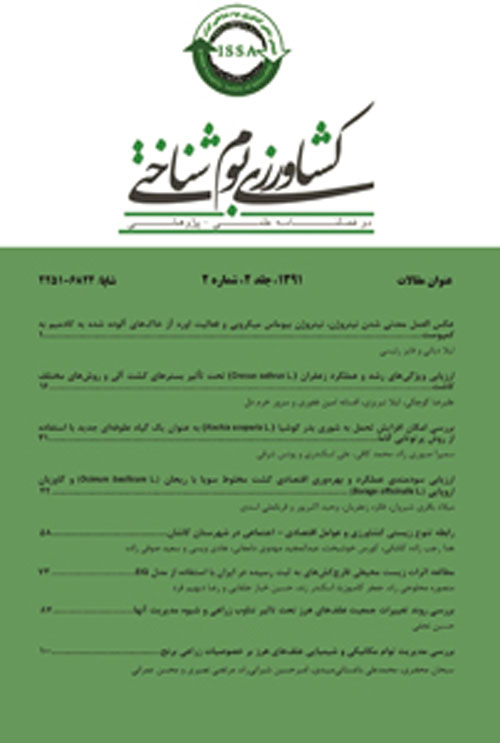The effect of tillage systems and seed priming on the allocation main stem and branches in soybean yield
Author(s):
Abstract:
Introduction
Conventional soil tillage (CT), such as mouldboard ploughing and rotary ploughing aggressively disturb the surface soil layer every year. In the short term, these systems create a good soil physical environment for crop emergence, rapid early growth, nutrient uptake, and high crop yield (Six et al., 1999). However, over the long term, the soil structure becomes degraded and soil organic matter (SOM) mineralization is increased, leading to SOM and nutrient content depletion, soil compaction and soil erosion (Triplett and Dick, 2008). All of these processes degrade well-structured soil and obstruct farmland sustainability (Fernandez et al., 2009). Hence, adoption of conservation tillage practices, for example no-till (NT) and reduced-till (RT), has been widely accepted over the last two decades in selected areas (Triplett and Dick, 2008). Conservation tillage improves economic performance and energy use efficiency, and reduces production risks; it also decreases soil disturbance, improves SOM maintenance and benefits soil quality (Zentner et al., 2004). Lafond et al. (1996) reported that conservation tillage increases pea, flax and spring wheat grain yields.Materials And Methods
Considering that there is little information available about the differences in variety with the ability to allocate between the main stem and branch yield response to tillage systems, a field experiment was therefore conducted in 2014 on a split factorial in a randomized complete block design with three replications at the research farm of the College of Agriculture and Natural Resources of Tehran University in Karaj. The main factor includes two types of tillage systems (conventional tillage and no-tillage) and the subplots of three cultivars (L17, Williams, Nekador); the third factor was priming (priming with potassium nitrate 0.4 %) and no-priming (control) to the factorial in the main plots were broken. In this experiment, characteristics such as the number of branches per plant, yield and yield components on the main stem and branches were measured.Results And Discussion
Plant density (m-2) was significantly affected by the interaction between the seed priming and tillage system, and the effect of the choice of cultivar as well. The interaction between tillage system, cultivar and priming was statistically significant on the number of seeds in the pod, grain yield on main stem, number of seeds in the plant and thousand seed weight of soybean. In addition, interaction between seed priming and tillage system was significant on the thousand seed weight on the main stem and grain yield of branches. The number of pods in the plant and the grain yield of branches were influenced by the interaction between cultivar and tillage system, while the number of seeds in the plant and the grain yield of branches were affected by interaction between the cultivar and priming. The effects of cultivar and tillage systems were significant on the number of branches on the plant and grain yield on the main stem. Final grain yield on the main stem and branches of soybean were affected by the tillage system, cultivar and priming.Conclusion
Maximum plant density (25 plants in m-2) was observed when the conventional tillage system was used under control conditions. Seedling establishment of soybean was lower as the result of seed priming and tillage system. The maximum grain yield was observed in L17 under the conventional tillage system and without seed priming, but Nekadar produced the minimum grain yield. Non-priming of the seed (control) in the normal tillage system produced the maximum grain yield in branches and primed seeds of soybean under the conventional tillage system produced the minimum grain yield. The grain yield of branches under the normal tillage system was higher than with the conventional tillage system in the Williams cultivar. The maximum contribution of grain yield under the conventional tillage and normal tillage systems was related to main stems and branches, respectively. Keywords:
Language:
Persian
Published:
Journal of Agroecology, Volume:6 Issue: 2, 2017
Page:
259
https://magiran.com/p1680995
مقالات دیگری از این نویسنده (گان)
-
Application of hydrothermal time model to determine the cardinal temperatures for seed germination in crops (A case study; velvetleaf (Abutilon theophrasti med.))
Esmaeil Yasari, Mousa Miri, Sadegh Atashi, *
Iranian Journal of Seed Science and Technology, -
Effect of seed priming on soybean yield and yield components in different tillage systems
M. Jamali, M.R. Jahansuz *, Reza Tavakkol Afshari, J. Asghari
Iranian Journal of Seed Science and Technology,


